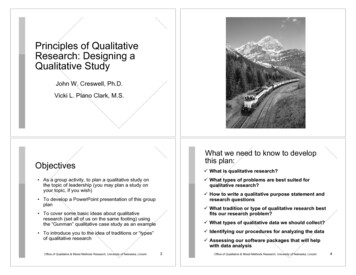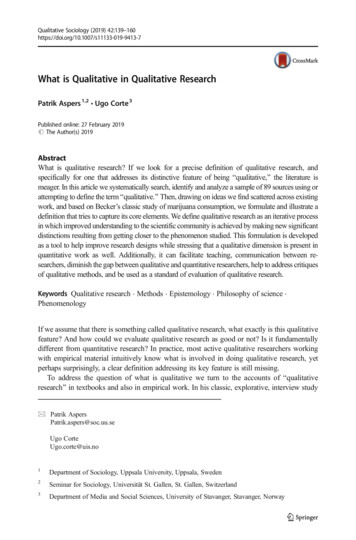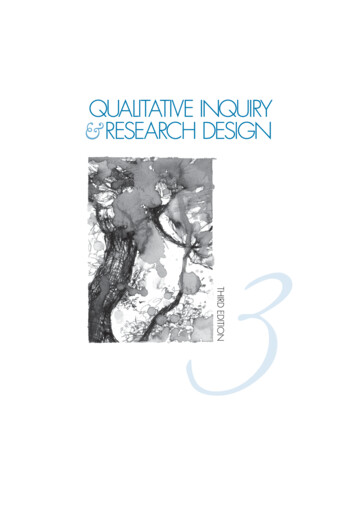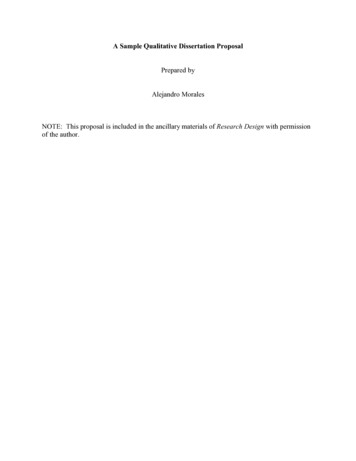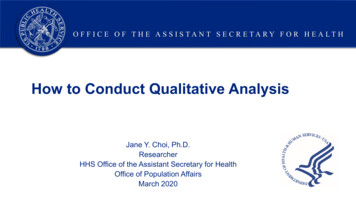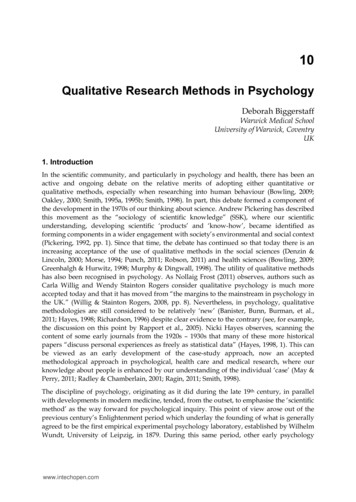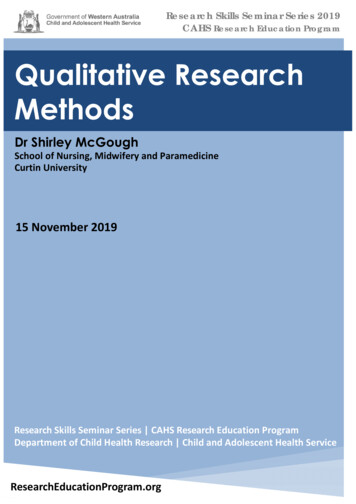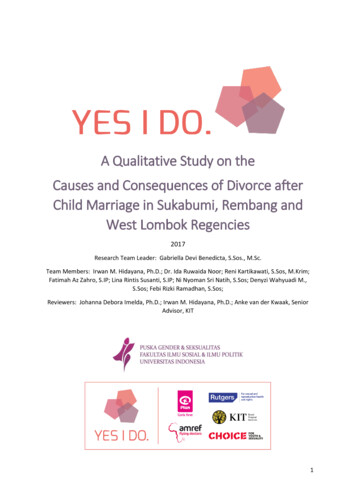
Transcription
A Qualitative Study on theCauses and Consequences of Divorce afterChild Marriage in Sukabumi, Rembang andWest Lombok Regencies2017Research Team Leader: Gabriella Devi Benedicta, S.Sos., M.Sc.Team Members: Irwan M. Hidayana, Ph.D.; Dr. Ida Ruwaida Noor; Reni Kartikawati, S.Sos, M.Krim;Fatimah Az Zahro, S.IP; Lina Rintis Susanti, S.IP; Ni Nyoman Sri Natih, S.Sos; Denyzi Wahyuadi M.,S.Sos; Febi Rizki Ramadhan, S.Sos;Reviewers: Johanna Debora Imelda, Ph.D.; Irwan M. Hidayana, Ph.D.; Anke van der Kwaak, SeniorAdvisor, KIT1
Table of Contents . 2List of Tables . 4List of Figures. 4List of Terms . 4List of Abbreviations . 6Executive Summary . 8Chapter 1. Introduction . 13BACKGROUND . 13PROBLEM STATEMENT . 13RESEARCH OBJECTIVES . 14STRUCTURE OF THE REPORT . 14Chapter 2. Methodology . 15STUDY DESIGN . 15RESEARCH AREAS . 15DATA COLLECTION TECHNIQUES. 15SAMPLING AND RECRUITMENT OF STUDY PARTICIPANTS . 16DATA COLLECTION AND ANALYSIS . 16VALIDATION AND DISSEMINATION OF RESEARCH . 17QUALITY ASSURANCE . 17ETHICAL CONSIDERATIONS . 17STUDY LIMITATIONS . 17LITERATURE REVIEW METHODS . 18Chapter 3. Literature review . 19DIVORCE AFTER CHILD MARRIAGE AT THE GLOBAL LEVEL . 19THE SITUATION OF DIVORCE AND CHILD MARRIAGE PRACTICES IN INDONESIA . 19Chapter 4. Child marriage and divorce: Sukabumi case . 21SOCIO-CULTURAL CONTEXT OF CISOLOK VILLAGE, SUKABUMI . 21RELATIONSHIPS BETWEEN YOUTH IN CISOLOK VILLAGE . 23CHILD MARRIAGE IN CISOLOK VILLAGE . 24ILLEGAL BUT LICIT: THE PRACTICE OF DIVORCE AFTER CHILD MARRIAGE IN CISOLOK VILLAGE . 28Chapter 5. Child marriage and divorce after child marriage: Rembang case. 38SOCIO-CULTURAL CONTEXT OF MENORO VILLAGE, REMBANG . 38FROM FACEBOOK TO BECOMING ‘AN ITEM’ : DATING AMONG MENORO VILLAGE YOUTH . 40CHILD MARRIAGE AND MATCHMAKING IN MENORO . 412
DIVORCE AFTER CHILD MARRIAGE IN MENORO VILLAGE . 44Chapter 6. Child marriage and divorce: West Lombok case . 54SOCIO-CULTURAL CONTEXT OF KEDIRI INDUK VILLAGE, WEST LOMBOK . 54“ELOPEMENT” DUE TO “LOVING EACH OTHER”: CHILD MARRIAGE IN KEDIRI INDUK VILLAGE . 56“MARRIAGE IS LIKE DATING, DIVORCE IS LIKE BREAKING UP”: THE PHENOMENON OF DIVORCEAFTER CHILD MARRIAGE IN KEDIRI INDUK VILLAGE . 58Chapter 7. Discussion . 67SIMILARITIES BETWEEN THE THREE RESEARCH AREAS . 67DIFFERENCES BETWEEN THE THREE RESEARCH AREAS . 68CHANGE OF STATUS AND THE ROLE OF THE GIRLS DUE TO DIVORCE AFTER CHILD MARRIAGE . 69STORIES ARE TOLD TO FRIENDS, BESIDES THE FAMILY . 70THE ROLE THE LOCAL GOVERNMENT . 70THE ROLE OF KPAD IN THE YES I DO PROGRAMME . 71LESSONS LEARNED AND NOVELTY OF THE STUDY . 71Chapter 8. Conclusions and recommendations . 73CONCLUSIONS . 73RECOMMENDATIONS . 74References . 78Annexes . 803
Table 1 Research areas . 15Table 2 The number of main study participants based on marital status . 16Table 3 Population of Cisolok village in 2017 by age group . 21Table 4 Level of education completed in Cisolok village . 21Table 5 Variations of gender inequality in child marriages in Cisolok village . 27Table 6 Recapitulation of case reports received by the Cibadak Religious Court, Sukabumi Regency 28Table 7 Level of education completed in Menoro village . 39Table 8 Participation of divorcees in community activities . 51Table 9 Research recommendations . 74Figure 1 Sample talaq declaration letter, an illegal but licit Divorce Certificate . 30Figure 2 One of the economic activities of female farm labourers in Menoro village . 38Figure 3 Some girls in Menoro village walking to a musholla to read the Koran . 39Figure 4 The identity of ‘Santri Village’ in public facilities . 54Figure 5 Head of Hamlet’s records of couples who have married and divorced . 60Figure 6 Children playing outdoors in the crowded residential area . 64Figure 7 Change of status and role of the girls after divorce . vorce after Child MarriageDukuh/dusun (Hamlet)Unofficial servant at the Office of Religious Affairwhose jobs to take care of marriages and mattersrelating to religious affairsForm of Rotating Savings and Credit Associationin Indonesian culture, a form of Microfinance.Generally the arisan is a social gathering thattakes place at a fixed intervalDivorced woman (Sasak language)The process of separating an eloped couple inthe Sasak cultureThe activity of having fun and spending timewith friends; hanging outA person finding a mate for another person;matchmaker. Usually a man/woman consideredas an elder, can be a commoner or a kyaiA genre of Indonesian folk and traditionalpopular musicA married couple in which one party was under19 years at the time of marriage, and who havelater divorcedAn administrative-social unit under a village4
DukunHHadrahIIddahJJanda HerangKKawin SiriKimcilKodekKyaiLLanggarMMadrasah DiniyahMadrasah TsanawiyahMajlis ajianSomeone considered to possess supernaturalpowers/shamanA form of Islamic musical artThe waiting time after a divorce in Islamic lawafter which one is allowed to remarryA term for a pretty divorced young womanA wedding witnessed only by a modin and awitness, not registered in the Office of ReligiousAffairs, considered valid according to Islamic lawLady companions escorts(Javanese/traditional) expert in Islam(Javanese/traditional) expert in IslamHouse of prayer at village levelReligious based education system, usuallyinformalIslamic school equivalent to junior high schoolKoran recitation activitiesTo take a woman surreptitiously (elope) withthe intent to force a marriageTo take someone away (Sasak language)A person who has duties and functions in therecording of death and everything related todeath, marriage, talaq, divorce, andreconciliation. He also facilitates the fostering ofharmony among religious followers, social,cultural and religious communities.Receiving education in a pesantren‘Spinster’ in Sasak languageAny person who is prohibited to be married dueto descent, blood relations and marriage inIslamic rule (in Arabic also called mahram)Place to pray for Muslims (in general)Collecting grass for fodder and feeding livestockPre-wedding tradition of Menoro Village,Rembang. In this tradition, the family of thebride visits the house of the groom’s family,bringing foodstuffs.Studying and staying in a pesantrenMake money contributions to pay for aperformerSasak tradition of parading a newlywed coupleto inform the public that they have just marriedKoran recitations5
Perawan TuaPesantrenRRapakRondo adusKemenagKITKKKPADKUAA derogatory term of unmarried women whoare older than the average age when womenare expected to be married; SpinsterIslamic boarding schoolDivorce initiated by the wifeYoung divorceeSomeone receiving Islamic religious educationin a pesantren, usually boarding there until theconclusion of their educationA wedding conducted in accordance to Islamiclaw but not state lawIslamic lawIn classical Islamic law refers to the right of thehusband to dissolve marriage simply bypronouncing to his wife ‘I reject’.1Informal activity of Islamic disseminationSexual intercourse between man and womannot under the bounds of marriage.Anak Buah Kapal (seaman)Aliansi Remaja IndependenBadan Peradilan Agama (Religious Court)Bimbingan Masyarakat (Societal Education)Badan Penasihatan Pembinaan dan Pelestarian Perkawinan (Marriage CounselingAgency)Badan Pusat Statistik (Statistics Indonesia)Diploma 2 (two-year higher vocational education)Dinas Pendidikan, Pemuda, dan Olahraga (Office of Education, Youth and Sports)Dinas Pengendalian Penduduk dan Keluarga Berencana (Office of Population Controland Family Planning)Dinas Sosial, Pemberdayaan Perempuan dan Keluarga Berencana (Office of SocialService, Women Empowerment and Family Planning)Forum Anak Desa (Village Youth Forum)Gerakan Anti Merariq Kodek (Movement Against Elopement at a Young Age)Generasi Sehat dan Cerdas (Healthy and Smart Generation)Kepala Dusun (head of hamlet)Kementerian Agama (Ministry of Religious Affairs)Royal Tropical InstituteKartu Keluarga (Certificate of Family Members)Kelompok Perlindungan Anak Desa (Village Child Protection Committee)Kantor Urusan Agama (Office of Religious Affairs)1 Abed Awad and Hany Mawla (2013). “Divorce. Legal Foundations.” The Oxford Encyclopedia of Islam and Women. Oxford: Oxford UniversityPress.6
nduPUPRARTRWS1S2SDSLTASLTPSMKSMSTKITKWUPT DPPKBMadrasah Aliyah (Islamic school equivalent to elementary school)Madrasah Ibtidaiyah (Islamic school equivalent to elementary school)Madrasah Tsanawiyah (Islamic school equivalent to junior high school)Non-Governmental OrganizationWest Nusa Tenggara provinceReligious CourtEarly Childhood EducationPembinaan Kesejahteraan Keluarga (Family Welfare organization)Civil ServantPekerja Rumah Tangga (domestic worker)Pusat Kesehatan Masyarakat (Community Health Center at district level)Pusat Kesehatan Desa (Community Health Center at village level)Pos Pelayanan Terpadu (Unified Service Delivery Unit, first-line health servicedeliverer)Peningkatan Usia Perkawinan (Raising the Age of Marriage)Raudhatul Athfal (Islamic school equivalent to kindergarten)Rukun Tetangga (Smallest neighborhood unit consisting of 10-50 households)Rukun Warga (Neighbourhood unit consisting of 3-10 RTs)Strata Satu (Undergraduate)Strata Dua (Graduate)Sekolah Dasar (Elementary School)Sekolah Lanjutan Tingkat Akhir (High School)Sekolah Lanjutan Tingkat Pertama (Intermediate School)Vocational schoolShort Message ServiceTenaga Kerja Indonesia (Indonesian migrant worker)Tenaga Kerja Wanita (Female migrant worker)Unit Pelaksana Teknis Dinas Pengendalian Penduduk dan Keluarga Berencana(Technical Implementation Unit of Population Control and Family Planning ServiceOffice)7
Although there are no statistical data showing the relationship between child marriage and the rate ofdivorce, there are indications that child marriage contributes to divorce rates in Indonesia. Researchon child marriage conducted by PLAN International (2015) in Pakistan, Bangladesh and Indonesia foundthat the objection of young people to child marriage was considered to cause disharmony, conflictsand domestic violence in marital relations, and sometimes divorce. Studies on divorces in the contextof child marriage in Indonesia are few and the study presented in this report is an attempt to fill thisresearch gap.The study had the general objective of identifying the causes and consequences of divorce after childmarriage in three areas of the YES I DO programme, namely Sukabumi, Rembang and West LombokRegencies. Specifically, this study observed the types of divorce, causes and consequences of divorce,and the post-divorce coping mechanisms. The YES I DO programme in Indonesia is a collaborationbetween Rutgers WPF Indonesia, Plan Indonesia and Aliansi Remaja Independen (ARI). The study wasneeded to inform the activities of these YES I DO partners in the three areas.The research was conducted in three areas of the YES I DO programme, namely the Cisolok village inSukabumi Regency (West Java), Menoro village in Rembang Regency (Central Java) and Kediri Indukvillage West Lombok Regency (West Nusa Tenggara). All areas have a high rate of child marriage,however, they have different characteristics. For example, Cisolok is semi-urban, Menoro is rural andKediri Induk is an urban area.There were 46 interviewees from the three areas: 30 main participants and 16 key informants (such asfamily members, teachers, policy stakeholders). The main participants were males and females whowere divorced after child marriage; seven were in the age group of 15-18 years and 23 were in the agegroup of 19-24 years. Of them, 21 had an unregistered divorce and nine had a registered divorce.Participants of the FGDs were general community members, grouped by age and gender. FGDs wereconducted with two age groups, those between 18 and 24 years (one FGD with males and one withfemales) and those aged 25-50 years (also one FGD with males and one with females), and each FGDconsisted of six to eight participants. In addition to the both research techniques, this research alsoused the photo voice technique.Transcripts of the in-depth interviews and FGDs were uploaded, coded and analysed using NVivosoftware. The findings of the research were discussed with the YES I DO Alliance in Jakarta in November2017. Research dissemination and validation workshops were also held in each area with local partnersand other stakeholders. The workshop in Rembang was held on December 11, 2017 while theworkshops in Sukabumi and West Lombok were held on December 19, 2017. In each workshop, theresearchers presented the main findings of the study to get input and recommendations, especiallyrelated to the stakeholder’s programmes at district level.This study has obtained the ethical clearance from the Research Ethics Committee of Faculty of PublicHealth, Universitas Indonesia in the letter No. 493/UN.F10/PPM.00.02/2017.8
One of the prominent impacts of child marriage in the three areas was economic problem. Girls haddropped out of their schools and boys found it difficult to find a job to provide for their family. Youngcouples were hardly able to make ends meet without the support from their parents. These economichurdles sometimes generated tensions that culminated in a fight between young husbands and wives.The tension was said to increase when it is the wife who works while the husband is unable to be areliable provider for the family. Gender inequality in the division of roles within the family alsotriggered the occurrence of household problems that lead to divorce. In West Lombok, although it wassaid that women can work, men are obliged to provide the livelihood. In Sukabumi, although womenhave greater access to employment than men, the permission to work remains in the hands ofhusbands who have the main responsibility to earn in the family. In the case of Rembang, men werereported to play a very dominant role in the family, especially in economic terms, marginalizing theposition of women to take care of domestic issues.In the midst of economic difficulties and pressures from gender roles and expectations, it appearedthat young couples also struggle with their emotional immaturity, at times is manifested in possessiveattitudes towards the partners and infidelity. In Sukabumi and Rembang there were cases of infidelityreported, although not many. In West Lombok, affairs were more frequently found. Some of thesecases of infidelity in West Lombok were with former lovers, while in Rembang, infidelity occurred dueto migration of partners. When the husband worked elsewhere, he may have met another woman,and got remarried. As explained by study participants, emotional immaturity of young couples in theface of domestic problems often leads to prolonged quarrels. Trivial matters could trigger discord,violence and even divorce.Emotional immaturity in some cases was also reflected in how young people develop theirrelationships from the beginning. In some cases encountered, marriages were the culmination ofgetting acquainted on the social media such as Facebook. One reported cause of divorce after childmarriage in Sukabumi was due to the lack of awareness of the youth to further examine the familybackground of their partners. Some of the relationships that began via social media ended in divorce.Matchmaking was another reason mentioned for divorce. In the case of matchmaking, initially, girls donot have the autonomy to determine their partners, but various problems experienced duringmarriage embolden them to file for divorce, as indicated by several study participants. Interference ofparents in a (married) child’s domestic life could also worsen the condition of the household, endingin divorce. Furthermore, some participants said that when marriage occurs because of premaritalpregnancy, most marriages will end shortly after the child is born.In the three research areas, there was stigma related to spinsters and young female divorcees. Somegirls chose to marry at a young age rather than becoming an ‘old maid’ or spinster, despite the risk ofdivorce after child marriage. Even though it was undesirable, divorce was common in the researchareas and was not considered as taboo.The study found that after divorce, both parties return to their parents. If the divorcing couple haschildren, then custody of children in general will fall to the mother. In the three research areas, themajority of study participants indicated that divorced women become a burden to their families, asparents not only have to support their children, but also their grandchildren.9
It was found that some villagers in Cisolok (Sukabumi) and Kediri Induk (West Lombok) tend not toregister marriages legally, both in KUA (the Office of Religious Affairs) and civil records, due to illegal(but valid according to religion) marriages. Likewise with divorce, people in these two villages tendednot to register their divorce to the Religious Court, even if they were legally married.Some of the participants interviewed in Cisolok (Sukabumi) did not register their marriage to KUAbecause child marriage is prohibited. The common practice was to conduct sirri marriage2 in front ofthe village amil; or falsify the age of the child to a legal marriage age. None of the participantsinterviewed in Cisolok registered their divorce to the Religious Court for economic reasons. Thepractice around a divorce included signing a stamped talaq (divorce) certificate signed by both partiesand the head of Rukun Tetangga3 (RT)/ Rukun Warga4 (RW), because the couples could not afford theadministrative cost of the KUA marriage and the divorce fee (on top of transport to the Religious Courtlocated about 30 to 60 minutes from the village). The practice, albeit illegal, was socially recognized.In Kediri Induk village, the tendency of people not to register marriage and divorce was moreinfluenced by the local Islamic culture. Although sirri marriage and talaq were not legal, they weresocially and religiously recognized. In Menoro village, in general, people tended to register theirmarriage and divorce legally, because of public awareness to formalize divorces. One of the reasonswas the mudin5 who mediated the processing of divorce for Menoro village community members.Due to the lack of job opportunities in Cisolok village, young women who divorced after child marriagewere encouraged to migrate for work. The migration destinations of these young women were to thecities, to become factory workers, and abroad to become migrant workers (to Hong Kong, Taiwan,Saudi Arabia). This poses a new vulnerability for young women. In Kediri Induk village, one of thedefense mechanisms of young men and women who divorced after child marriage was migrating tolook for jobs outside the village, and some migrated abroad although this was not common. In Menorovillage, participants reported that one of the survival mechanisms of divorced men to forget theproblem is alcoholic drinks, whereas girls usually will be sent to pesantren (Islamic boarding school) bytheir parents or look for work outside Menoro.The study showed that divorce has varying effects on the educational situation of divorced girls. In allthree areas there are opportunities to access education. In Cisolok, there is a choice of education inthe form of PKBM and GSC programmes in formal school, whereas in Kediri Induk there is an openschool. However, these opportunities were not always accessed by the divorcees. This was due toeconomic and social reasons, namely the shame that comes with the status of being divorced. Unlikethe two other areas, in Menoro village, the pesantren was an alternative choice of education that couldbe accessed by adolescents who experienced divorce. Some cases indicated that divorcees werecontinuing their education in pesantren, whether requested by the parents or by their own desire.In addition to the various problems experienced after divorce, some of the participants actually feltmore comfortable, free, happy and have control over themselves.23A wedding conducted in accordance to Islamic law but not state law.Smallest neighbourhood unit consisting of 10-50 households.4Neighbourhood unit consisting of 3-10 RTs.A person who has duties and functions in the recording of death and everything related to death, marriage, talaq, divorce, andreconciliation. He also facilitates the fostering of harmony among religious followers, social, cultural and religious communities.510
Unlike child marriage, the phenomenon of divorce after child marriage has not been the concern oflocal governments. In West Lombok, the Government has issued Circular Letter (SE) NumberSE/150/1138/KUM, setting the age of marriage to above 20 years. The Regent of West Lombok wasalso quick to respond to this circular by launching the running Anti-Merariq Kodek Movement (GAMAK)to the village and hamlet levels.In Rembang, Dinsos PPKB has a programme focusing on economic and social counseling for divorcees.In addition, the Government of Rembang Regency also has the Peningkatan Usia Perkawinan (PUP,Raising the Age of Marriage) programme, targeting teenagers and families.In Sukabumi, BP3AKB of Sukabumi Regency has a Firstborn Postponement programme (postponing thebirth of the firstborn by three years through family planning) in case of child marriage. In addition,BP3AKB also has a PUP programme and community and school-based PIK R programme. In schools,the Sekolah Siaga Kependudukan (SSK) programme has been implemented in SMPN 1 Cisolok andSMAN 1 Cisolok.Since early 2017, the Village Child Protection Groups (KPADs) in the three study areas have beenactively running their activities. The main KPAD activities are to assist and educate the public aboutchild marriage. In West Lombok, KPAD together with the government were said to play a role indocumenting and accompanying the process of belas (separation) in the event of merariq6. This role issignificant because it involves the negotiation process to allow the marriage or not.In Rembang, the existence of KPAD was supported by the Regional Regulation of Rembang RegencyNo. 6 of 2014 on the Implementation of Child Protection, namely in Article 6 point (b) which discussesthe importance of the existence of KPAD at the village level. In addition to providing assistance toparents of married children, Menoro KPAD also conducted socialization focusing on the prevention ofchild marriage. This socialization was conducted through various village activities, and KPAD wasfunded by the APBDes.In Sukabumi, since the KPAD was newly established (less than one year), its role so far has beenconducting raising awareness about child marriage prevention in school committees, village meetings,and Majlis Ta’lim (Koran recitation activities). In addition to the institutional role, the head of the KPADwas said to have had a significant role in facilitating the prevention of divorce after child marriagethrough consultations.There were two types of divorce that occur after child marriage, namely registered and unregistereddivorce. In Menoro village, the majority of divorces were registered. This is in contrast to the other twoareas, where the majority of divorces were unregistered. In Kediri Induk village, most cases of divorceafter child marriage were not officially registered. This made that possible remarriages would (also) besirri marriages. In Cisolok village, although most divorces were not registered in the Religious Court,there was a certificate of stamp duty issued by the head of RT/RW. By using this “divorce certificate”,divorced parties could remarry formally in the local KUA.Divorce occurring after child marriage, whether registered or unregistered, was caused by variousfactors. Some of the reasons as mentioned by study participants included economic problemsemotional immaturity, infidelity, and domestic violence, but also matchmaking, premarital pregnancy,and parental intervention. Many of these factors are manifestations of the imbalanced genderrelations in all three study areas, both in the family and at community level.6To take a woman surreptitiously (elope) with the intent to force a marriage.11
Divorce had several impacts, including the additional economic burden of
The study had the general objective of identifying the causes and consequences of divorce after child marriage in three areas of the YES I DO programme, namely Sukabumi, Rembang and West Lombok Regencies. Specifically, this study observed the types of divorce, causes and consequences of divorce, and the post-divorce coping mechanisms.
